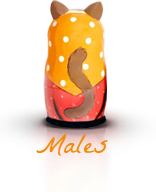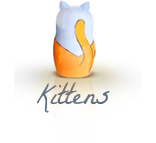Norwegian Forest Cat or Skogkatter is the most common breed of long-haired cats in the Nordic countries. These charming little trots are an integral part of Norway nature.
In Norway they are known as the skogkatt/skaukatt which means forest cat ("skog" and 'skau" being alternate words for "forest" in different norwegian dialects) and as the Norsk Skogkatt (Norwegian Forest Cat).
Norwegian Forest Cat has long and waterproof dense fur, large ears with tassels and a fluffy tail. The color is different except for contrasting marks on paws, tail, ears and a muzzle, the same as Siamese cats have.
This is a large, but an elegant cat. It likes freedom, but tends to be sociable with people, too, it’s brash, but curious and sociable. This cat won’t bother with its presence, but at the same time can give an entire tirade if thinks that you have been away from home for too long. And you will get all this: a greeting and a story of what happened during your absence, and finally the question of where you've been for so long.
Like all big cats Norwegian Forest matures to 3-4 years. Because of its fur they seem very large. Adult male weighs about 8-9 kg, female is a little less. In addition to the fur, an elongated, strong, but an elegant body, that is characteristic more of trots than cats, and the proportion of front and back limbs make look like giants. This combination allows a Norwegian Forest cat, virtually the only one of domestic cats, to descend from a tree upside down in a spiral, like a squirrel.
Because of low prevalence of this breed in Russia Norwegian cats are often confused with maine сoons and siberians. Yet each species has its characteristic differences, which are clear at first glance once you see good representatives of each breed next to one another.
The Character
A norwegian is a great companion who is always near but does not impose the company, although gladly consorts you doing household chores or while talking a walk outdoors.
The cat perfectly gets along with other pets and children. If it doesn’t like something it would rather leave than persist, be angry and even revenge. It’s below its aristocratic dignity. Norwegian cats can easily get used to guests. A cat often greets visitors at the door and jumps on a lap as soon as they sit.
Taking care.
The Norwegian cats require daily fur care, especially in spring and summer. Norwegian Cats are excellent hunters, they like freedom, open air or free range. But despite this they easily adapt to life in the house.
The history of breed.
There are different theories of the origin of the Norwegian Forest cat, one of them is the following: these cats, longhair and shorthair, were brought to Scandinavia by ships of the Vikings, who were crossing the seas in Europe and Aisa from the ninth to the twelfth centuries. Norman pirates were afraid of plague (spreaded by rats), so they took cats from the shores of the Black Sea.
When the cats were brought to Scandinavia, they gradually adapted to the norwegian climate: their fur got thicker, developed an undercoat. Then these cats interacted with the European Shorthairto the result of a cat whose body composition and hair structure fully adapted to local environmental conditions and climate. Eventually these animals evolved and adapted to the harsh and cold climate of northern Scandinavia. As a result came the biggest, muscular, strong and healthy representative of the population.
Norwegians said this breed developed through snow, cold, rain, norwegian forest, sparsely populated areas, starvation and fear.
In general we can fruitfully investigate the ancestry of all norwegian cats for a long time, but lets it to antiques lovers or historians and let’s move to modern history when the scandinavian native cat got its present name.
The first written notice of norwegian cats can be considered a reference in a children’s book in 1912, and later in an autobiography of artist Olaf Gulbransson where he used an illustration made in 1910 of a representative of the breed.
Around the same time norwegian forest cats, recognized as wild, but useful animals, received official protection. In norwegian forest reserves foresters were responsible for these representatives of local fauna and had to monitor and stop poachers who caught and took out the cats out of the country.
Norwegian forest cats began to disappear as a species in consequence of mating with european shorthair. In order to avoid their complete disappearance people started to breed this species in the 30's of last century.
These cats were companions of Vikings. And recently this ancient norwegian breed has gained popularity at exhibitions around the world, from Japan and Australia to the Americas. Forest cats were mentioned in legends and myths of northern people for centuries.
The Norwegians say that the wild cat was in this region since ancient times. It was the first time that a representative of the Norwegian Forest breed participated in an exhibition in 1938 in Oslo, where it was evaluated by an expert from Denmark Knud Hansen as the National cat of Norway.
The Norwegian National Association of Pedigree or Norske Rasekattklubbers Riksforbund (NRR) was founded only in 1963 and a program for preservation of the national breed resumed only in 1972.
In 1938 breeders presented this breed for the first time and receiving positive feedbacks about it, continued breeding norwegian forest cats.
A year later in Norway the breed was approved and adopted as a single standard of the breed. Cats were given experimental pedigrees and in 1976 there were about registered animals in Norway.
The same year in Vesbaden (Germany) the annual meeting of FIFE took place where the breed "Norwegian Forest Cat" was approved as experimental and the distribution of species around the world began.
They were male Pan's Tigris, brown tabby, breeder Else Nylund, and Mjavo's Sala Palmer, black and white, breeder Solveig Stenersrod, bought by Sheila Gira, Michigan, of Mycoon cattery.
The cat breed was registered with the Department of Trade of Norway as exportable goods. All this time norwegian felinologists worked with this breed. And when in Paris in 1977 at a regular meeting of FIFE Frederick Nordan (President NRR) and other norwegian felinologists showed the audience a large number of photographs and pedigrees indicating the presence of cats of this breed for at least thee generations, they finally achieved the desired result and the breed “Norwegian Forest Cat” was officially approved.
Today this breed is one of the most popular in Scandinavia and distributed worldwide. It is always deeply admired and appealed to.
It was predicted a great future in Europe, which we can witness nowadays, and now this breed is among the top numerous ones at European exhibits.
As for the distribution of this breed in Russia, the population of the Norwegian cats is relatively small now but the interest to the norwegian forest cat is definitely growing and it will very soon be possible to see numerous members of this fascinating breed at cat exhibits held in our country.
Now these natives of Norwegian forests are recognized by all associations of cat lovers and live on all inhabited continents.
WCF Breed standards
Body:
From average to large, long, strongly built, solid bone structure. Long muscular limbs, hind legs are longer than front, wide and round feet with tufts of hair between toes. A tail is very long, at least equal to the length of a body, evenly pubescent with an abundant undercoat.
Head:
Right triangular or rounded, rather long profile; forehead slightly rounded; firm chin.
Ears:
Large, with good width at the base; pointed tips; with lynx-like tufts and long external hair. High placed and open, so that the outer lines of the ears follow the line of the head down to the chin.
Eyes:
large and oval, well opened, consistent coulour, harmonizing with the fur colour.
Coat:
moderately long, the undercoat is covered by a smooth, water repellant uppercoat, which consists of long, coarse and glossy fur covering the back and the sides. The lower part of the body and the back surface of the hind legs have no coat.
Colour:
a vast variety of colours, pointed patterns and chocolate, lilac, cinnamon and fawn ( including tabby, bicolor, tricolor) are not approved. Any shade and intensity of white is allowed.
Faults:
dry coat knotted with lumps, too silky
Vices:
short legs, a stocky body, a short nose with a break, a round or rectangular head, small ears in adult female cats (after two years), dry hair, a short tail and any significant deviation from the standard. A serious vice is a thin body. Colors on the basis of chocolate and lilac are evidence of crossing with other breeds.


